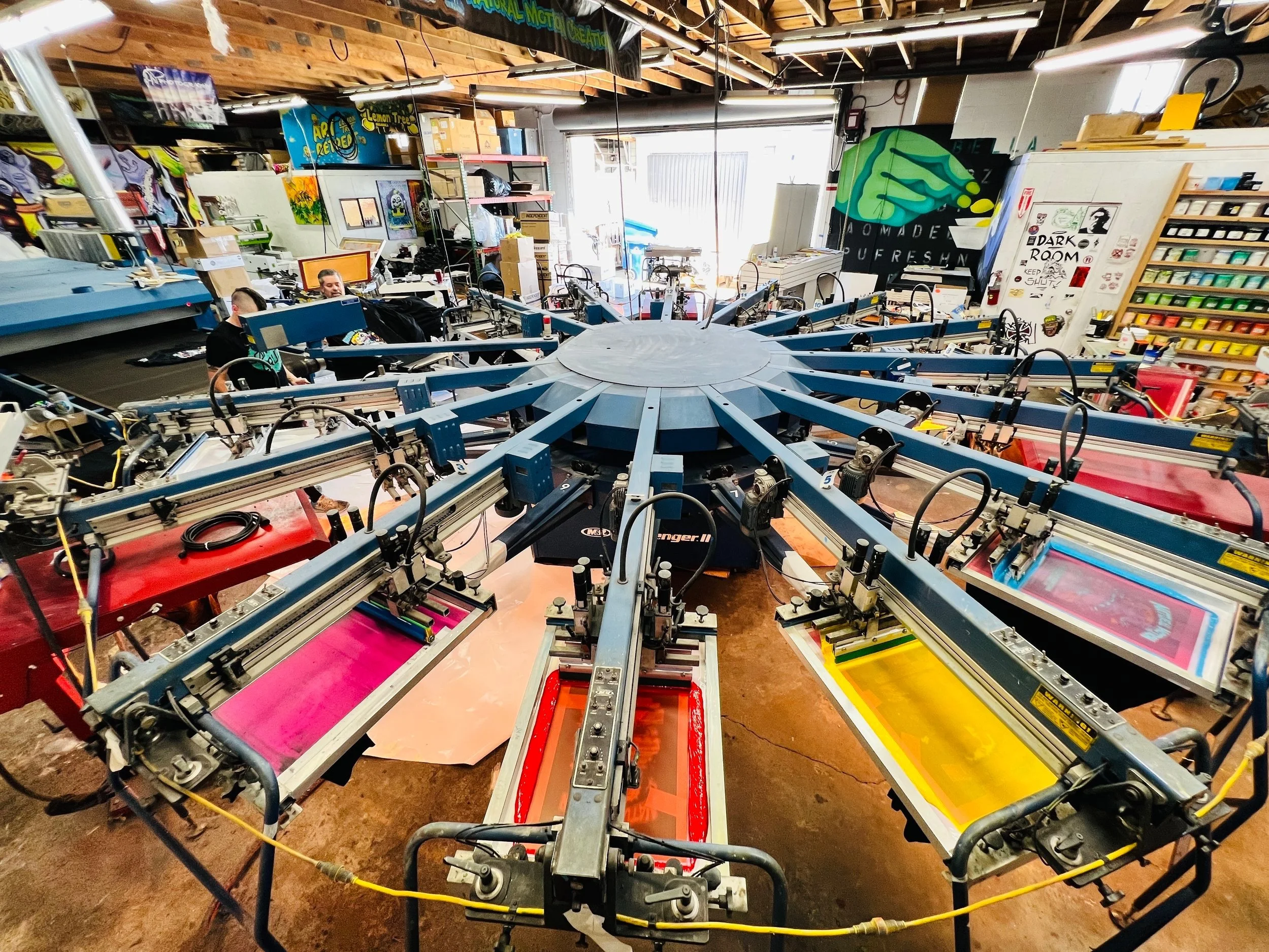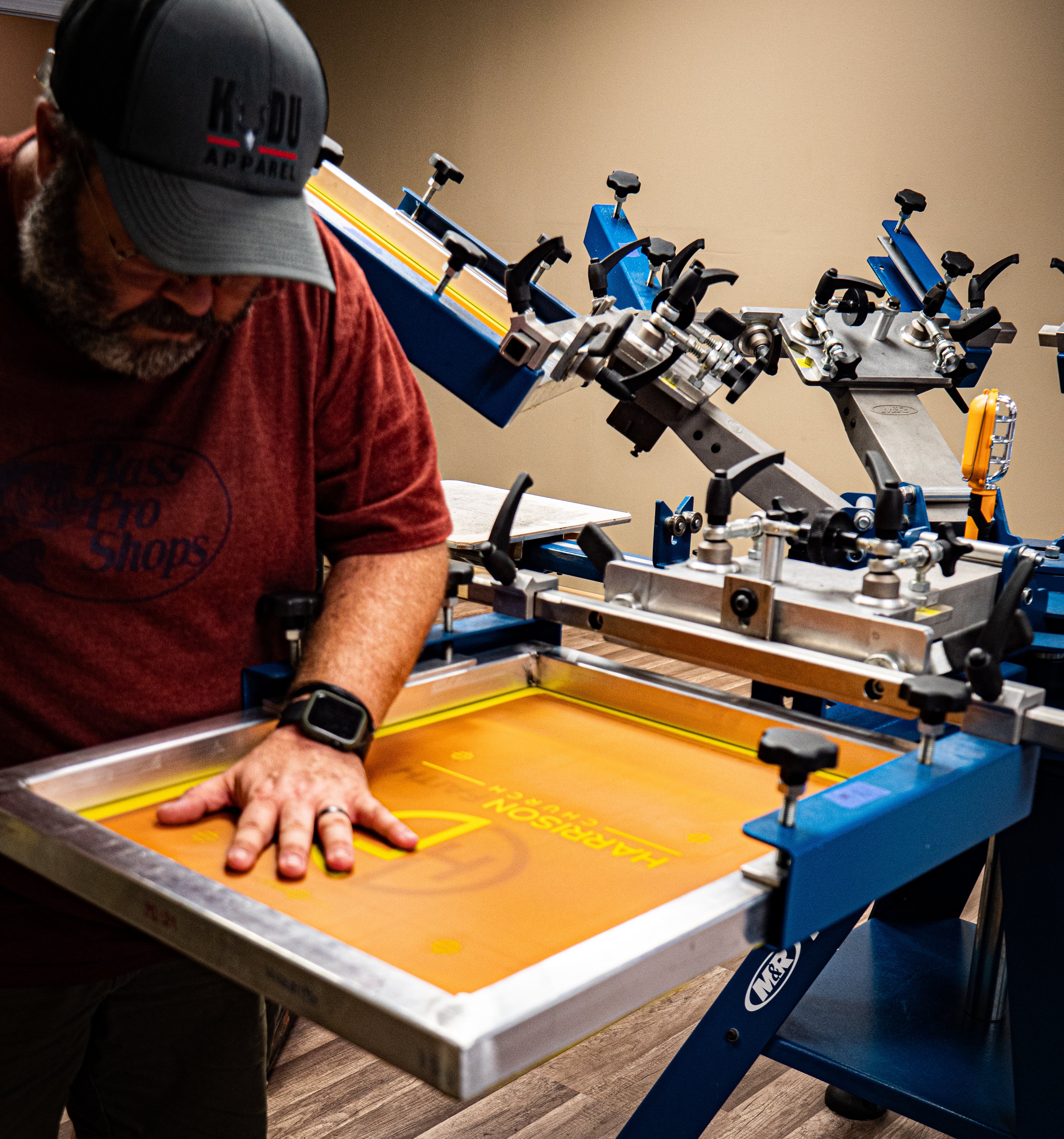Fast Turnaround Custom Screen Printing for Events
Wiki Article
Display Printing Uncovered: Whatever You Required to Find Out About Tee Shirt and Garment Printing Methods
If you have actually ever before asked yourself just how those vivid layouts wind up on your favored tees, you remain in the appropriate area. Display printing is a fascinating method that combines art with technique, offering unlimited possibilities for imagination. Comprehending the basics, from equipment to ink choices, can greatly impact your outcomes. All set to discover the essential elements that make screen printing an art form? Allow's reveal the details that can elevate your tasks.
The Essentials of Screen Printing: Just How It Functions
When you dive into display printing, you'll uncover it's both a scientific research and an art. At its core, display printing involves producing a stencil, or display, that allows ink to go through just in certain areas (screen printing kit). You begin by choosing your layout and preparing your screen with a light-sensitive solution. Once you reveal this emulsion to light, it sets, leaving your style as a negative area.Position the display over the material, then use a squeegee to press ink with the screen onto the garment. Each step is important, and understanding them will elevate your display printing skills, transforming easy garments right into unique, meaningful pieces.
Sorts Of Display Printing Strategies
As soon as you grasp the basics of screen printing, it's time to check out the various strategies that can boost your designs. One preferred method is traditional display printing, where ink is pressed with a stenciled screen. This strategy is excellent for vibrant, vivid shades. After that there's water-based ink printing, which provides a softer feel and is environmentally friendly, yet it calls for a various strategy to treating.If you're going for great information, consider discharge printing. This technique gets rid of dye from the fabric, leaving a soft, vintage appearance. An additional alternative is plastisol printing, known for its durability and vibrant colors, making it a preferred for lots of brands. Experiment with halftone printing to develop slope effects and complex layouts. Each strategy has its distinct beauty, so do not be reluctant to attempt them bent on discover what suits your design best!
Important Devices for Screen Printing
To attain spectacular results in screen printing, having the best tools is basic. You'll need a tough screen printing frame, which holds the mesh that moves your layout onto the garment. Next, invest in top quality mops; these are essential for applying ink uniformly across the screen.Choosing the Right Inks and Products
When picking inks and products for screen printing, you require to take right into account the sort of ink that functions ideal for your job. Think of material compatibility to guarantee your layouts look fantastic and last long. Check out green ink alternatives to make your printing process extra sustainable.Types of Display Inks
Choosing the right display ink is necessary for attaining dynamic, sturdy prints that satisfy your task's requirements. There are numerous kinds of display inks to analyze. Specialty inks, such as glow-in-the-dark or metal, can add one-of-a-kind effects to your designs.
Textile Compatibility Considerations
Understanding textile compatibility is important for accomplishing high-grade screen prints, especially given that various materials respond distinctively to numerous inks. When selecting inks, take into consideration the fabric kind-- cotton, polyester, or blends. For cotton, water-based inks work well, offering soft qualities and breathability. Polyester, on the various other hand, usually needs plastisol inks for better adhesion and dynamic shades. You could require to make use of a combination of both kinds if you're publishing on blends. Always test your inks on sample textile to ensure they stick effectively and preserve shade stability. Additionally, bear in mind that fabric weight and appearance can affect the final outcome, so picking the appropriate ink and product combination is crucial for your job's success.Eco-Friendly Ink Options
Environmentally friendly inks are coming to be a preferred choice for screen printers who want to minimize their environmental impact while keeping top quality. When choosing inks, take into consideration water-based inks, which are much less damaging and simpler to clean up compared to standard solvents.In addition, try to find inks made from renewable energies, such as soy or vegetable-based alternatives. By selecting the right inks and products, you'll not just create sensational layouts but additionally contribute to a much more sustainable printing process. Make the button, and your prints will mirror your dedication to the atmosphere!
Preparing Your Layout for Screen Printing

Submit Layout Requirements
To ensure your style looks vibrant and sharp on material, you'll require to pay close focus to submit format needs for display printing. Beginning with vector data like AI or EPS, as they can be scaled without shedding top quality. If you use raster photos, choose high-resolution files, such as TIFF or PNG, preferably at 300 DPI. Prevent making use of JPEGs, as they can shed quality when resized. Make certain your design has a clear background t-shirt printing to prevent unwanted white sides on your prints. Ultimately, keep color modes in mind; CMYK is standard for display printing, so transform your RGB makes appropriately. By following these standards, you'll establish your art work up for an effective print.Shade Separation Strategies
Color splitting up is an essential action in preparing your style for display printing, and grasping it can significantly enhance your print high quality. You'll need to damage your design right into individual shades, as each color calls for a different screen throughout printing. This precision not only guarantees exact shade representation but additionally streamlines the printing procedure.Resolution and Dimension
Accomplishing the very best cause screen printing starts with assuring your design has the appropriate resolution and dimension. Ideally, your art work needs to be at least 300 DPI (dots per inch) for sharp, clear prints. Your final item may look pixelated and unprofessional. if you utilize lower resolution.When it concerns size, think about the measurements of your print area. Design your art work to match the last print size, preferably producing it in the real dimensions you'll be printing. By doing this, you'll prevent any kind of unexpected scaling concerns.
Always inspect your layout in both vector and raster layouts. Vector graphics can be scaled without shedding high quality, making them optimal for display printing. Preparing appropriately will guarantee your design looks impressive on every garment!
Step-by-Step Display Printing Refine
Screen printing is a dynamic process that allows you to create dynamic styles on different surface areas. To begin, you'll require a display, solution, and your picked ink. Prepare your screen by cleaning it completely. Next, apply the emulsion uniformly and let it dry in a dark area. Once dry, expose your screen to light with your design put on it, which will certainly harden the solution where the light hits, creating a pattern - screen printing kit.Put ink onto the screen and use a squeegee to press the ink with the stencil onto the fabric. Lift the screen very carefully and allow the print completely dry. You've effectively screen printed your design.
Tips for Effective Display Printing Projects
While you're diving right into your display printing tasks, keep in mind that preparation is crucial to success. Begin by collecting all your products-- inks, garments, displays, and mops. A clean office assists stop undesirable errors, so clean before you begin.Following, validate your artwork is high-resolution and appropriately sized for your garment. Evaluate your screen for proper exposure and tidy it completely to stay clear of spots. When blending your inks, comply with the producer's standards to achieve the right uniformity.
During printing, use also pressure with your squeegee for regular outcomes. Don't hurry; take your time to confirm each print satisfies your standards. After printing, let your garments completely dry completely before handling or packaging them.
Finally, constantly maintain an example of your work for future recommendation. This means, you can assess your development and enhance your strategies over time. Pleased printing!

Often Asked Inquiries
For how long Does It Take to Set up a Display Printing Job?
Setting up a display printing task commonly takes around 30 mins to an hour. You'll prepare the displays, mix inks, and change the press. The moment differs based upon intricacy and experience, so stay organized!Can I Print on Different Fabric Keys In Making Use Of the Exact Same Method?
Yes, you can print on different textile types utilizing the exact same technique, however you'll require to change your inks and setups. Some materials soak up ink differently, so exploring guarantees the finest outcomes for every product.What Prevail Blunders to Avoid in Screen Printing?
When display printing, prevent common errors like making use of the incorrect ink, ignoring proper direct exposure times, or skipping pre-press checks. Always evaluate your configuration and maintain clean displays to guarantee quality outcomes each time.Just How Can I Effectively Clean and Keep My Display Printing Devices?
To properly tidy and maintain your display printing equipment, you must on a regular basis wash displays with appropriate solvents, inspect mops for wear, and guarantee all devices are stored dust-free and dry. Uniformity boosts and avoids pricey repairs efficiency.Is Screen Printing Eco Friendly Contrasted to Other Approaches?
Screen printing can be much more eco-friendly than various other methods, especially if you utilize water-based inks and eco-conscious materials. By picking lasting supplies and techniques, you decrease waste and lessen your impact on the earth.Display Printing Uncovered: Whatever You Need to Know About Tee and Garment Printing Strategies
At its core, screen printing involves producing a pattern, or display, that allows ink to pass through just in specific areas. Setting the display over the textile, then use a squeegee to press ink via the screen onto the garment. One popular technique is traditional screen printing, where ink is pushed with a stenciled display.When choosing inks and materials for screen printing, you need to take into account the type of ink that works finest for your job.
Report this wiki page